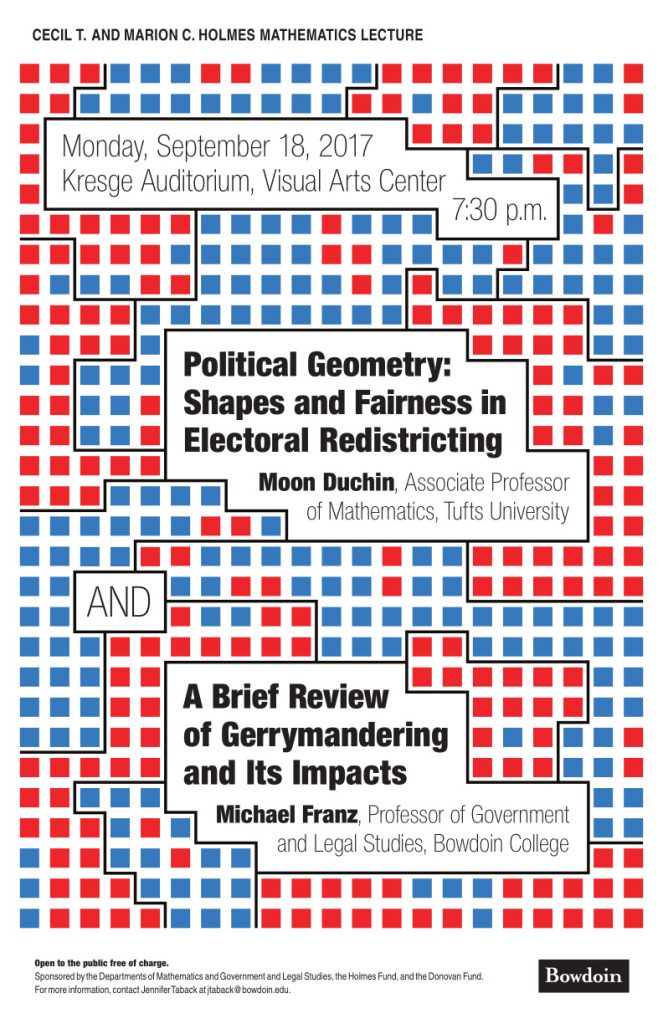Can Geometry Fix Partisan Gerrymandering?
By Rebecca GoldfineThough gerrymandering lands squarely in the political realm, math has always played a big role in congressional districting. Math determines how the U.S. counts voters in its Census and how those voters get divided up to apportion representatives to the government. And today, math could possibly lead the way to a more fair and just political system that is based on mathematically derived voting districts, according to an academic who visited Bowdoin this week.
Moon Duchin, an associate professor of mathematics at Tufts University, gave a talk Monday evening about how she is applying her expertise in the geometry of groups and surfaces to gerrymandering. “We’re looking at aspects of this big mess that is US congressional and legislative redistricting, and trying to find places where math has something to say,” she said.
In addition to her research, Duchin has also created a program — the Metric Geometry and Gerrymandering Group — to train expert court witnesses on the mathematical concepts behind congressional redistricting, which happens every decade after the decennial Census. More courts are hearing cases challenging new electoral maps, creating a need for people who can provide educated testimony, Duchin told the Higher Ed Chronicle.

Before Duchin spoke, Professor of Government Michael Franz offered a few statistics to highlight how problematic gerrymandering can be. “In 2012, after the GOP’s redistricting efforts in many states in 2011, the Democrats received more votes in all congressional elections, and nearly 51 percent of the two-party national vote to the GOP’s 49 percent,” he said. “But House Democrats picked up only seven seats and remained in the minority by 34. That’s 51 percent of the vote but only 46 percent of the seats…Democrats got more votes, but lost.”
Franz also touched on the history of gerrymandering and how this practice has been interpreted by courts. Additionally, he briefly described how different states deal with the (inevitably politically fraught) need to shape congressional districts so they meet several standard goals, such as being compact and contiguous while also containing equal numbers of voters.
Gerrymandering is, at a very basic level, a problem of geometry, which is why Duchin is in a good place to help stop its most pernicious outcomes. The fastest way to see whether gerrymandering is at play in a district, she said, is to assess how oddly shaped it is. For instance, a district in Illinois
“They’re not a smoking gun of evildoing,” she said. “But they might be a red flag.” For instance, it is currently allowable for districts to be drawn around groups with shared interests, say minorities, to give them a chance of electing someone who can represent their interests. And drawing a district can require some quirky outlines to both include a certain number of voters and also more or less follow town or city boundaries.
But politically motivated line-drawers can take this concept a step further, creating districts that they might argue merely group people with common interests together — when in fact they’re actually “packing” party-affiliated voters to contain them in one district. Or they’re “cracking” them up into several districts to sprinkle non-sympathetic voters throughout several districts to dilute their vote. This in effect becomes a form of voter suppression, according to people trying to stop it.
So Duchin is developing a mathematically-based strategy to help determine whether a funny-looking congressional district is indeed the result of packing or cracking. For one, instead of focusing on the outlines of a district — which has been the traditional approach for analysis — she, and the mathematicians she’s working
Mathematicians can also, she continued, draw better districts. “We want to be actually consulting for bodies that are drawing lines at all levels — congressional, legislative, city council, school board, water board. There are lots of lines drawn for political contests all around the country, and what we want is to help people, especially civil rights groups, draw districts that meet that balance between traditional districting principles and producing shapes that are less likely to get them thrown into a courtroom.”



